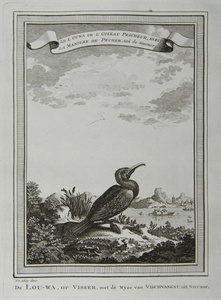| Method | Copper engraving |
| Artist | Jakob van der Schley |
| Published | [A la Haye, Chez Pierre de Hondt, MDCCXLIX. Avec Privilege de Sa Majeste Imperiale, & de Nos Seigneurs les Etats de Hollande & de West-Frise. 1749] |
| Dimensions | Image 191 x 140 mm, Plate 212 x 181 mm, Sheet 270 x 215 mm |
| Notes |
An illustration of a Chinese cormorant from the Dutch edition of the Description de la Chine, part of Prévost's monumental 'l'Histoire Géneral des Voyages.' The cormorant is depicted at centre, perched on a rocky shoreline near the ocean. In the background, a walled Chinese city can be seen, a tall pagoda dominating the small collection of buildings. On the harbour before the city, a number of fishing boats can be seen, the fishermen using the cormorants to assist them in their trade. The use of trained cormorants by Chinese fishermen fascinated early western travellers to China. The fishermen would attach a snare around the bird's neck, which would prevent it from swallowing larger fish. When caught, the fish would then be disgorged by the birds for the fishermen. Smaller fish would not be trapped by the snare, ensuring that the bird would still be able to feed itself. The plate ascribes the view to the descriptions of Johan Nieuhof. The Histoire Géneral des Voyages was a monumental eighteenth century general history divided according to geographic region. The original volumes were written by Antoine François Prévost d'Exiles, a French author, novelist, theologian, natural historian, and a priest of the Jesuit and Benedictine orders, but continued by numerous other authors after Prévost's death. The earliest books mostly deal with the Far East and South-East Asia, providing a general history of their regions, kingdoms, customs, culture, costumes, natural phenomena and religious beliefs. Much of Prévost's information is derived from the reports of Jesuit missionaries, Portuguese merchants, and famous explorers, from Marco Polo to Sir Francis Drake. Although written in French, the popularity of the Histoire among Dutch audiences meant that many of the illustrative plates and maps published to accompany the work were either re-engraved or subtitled in Dutch by the engraver Jakob van der Schley. Prévost himself had travelled widely throughout the Netherlands, launching his literary career in Amsterdam and the Hague after fleeing the Benedictines in France. Prevost's work on China, and indeed many of van der Schley's plates, owe a great debt to Johan Nieuhoff (1618-1672) , a Dutch traveller who explored much of China, India, and Brazil while in the employ of the Dutch East India Company. Nieuhoff wrote extensively, with a particular focus on China, for his memoirs, and his numerous drawings of Chinese places and people were much copied by later engravers for numerous works of Chinese interest. Nieuhoff's own book became a major source of inspiration for eighteenth century chinoiserie, and are amongst the first western illustrations to depict the Chinese people in a manner which was based upon personal observation rather than the tradition of oriental fantasy. Jakob van der Schley (26th July 1715 - 12th February 1779), also known as Jan von Schley or Jacobus van Schley, was a Dutch engraver and draughtsman. An apprentice of the French engraver Bernard Picart, he is best known for his engravings of the majority of plates in the Dutch edition of 'l'Histoire Géneral des Voyages.' Despite producing mainly maps and views for this work, van der Schley was predominantly a portrait artist and literary illustrator. Condition: Sheet trimmed within plate on right margin as issued. Binders crease and holes to left margin. Clean, crisp impression. |
| Framing | unmounted |
| Price | £45.00 |
| Stock ID | 40803 |

